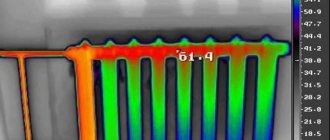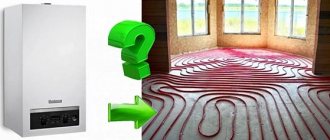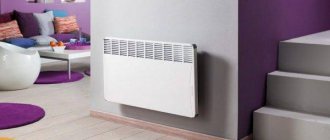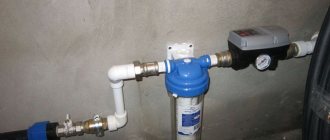Automatic air vent - how it works, why it leaks
Automatic air vents have not yet appeared that would not leak periodically. Which, in general, is not difficult to eliminate temporarily. Why do they leak, how to deal with it, and also why such devices are needed in heating, and how to use them correctly...
Why do you need an air vent?
Any closed pressure coolant system must have one or more air vents. At least one of them is automatic, releasing air on its own, without human intervention, as accumulation occurs.
This ensures the operability of the system and prevents airing. In an air-filled system, the coolant does not move normally, the equipment does not operate stably, noises and pops are heard - small water hammers. Equipment and pumps wear out faster.
Or the air lock will stop the movement of the coolant completely. Without a small device - an automatic air vent - the system will not work normally - airing will occur.
Where does the air in heating come from and how is it removed?
Air is dissolved in water (in the coolant) and is released when there are changes in pressure and temperature, forming bubbles that accumulate in the upper part of any system.
To remove air, it is necessary to install air vents in many characteristic places of the system, and automatic ones at the most important points where air accumulation is likely. To quickly, constantly bleed off the gas.
They also make separators - sections of pipe with a significant difference in diameter. In the area where the pressure decreases (the movement of the liquid accelerates), air bubbles are released, then they accumulate at the expansion - where they are removed by the described device.
Automatic air vent design
The device is based on a body with a float. The float is connected to a needle release valve, which is located at the very top. If the body is filled with water, the float closes the valve, and the outlet is closed. When air appears, water is displaced, the float sags, the hole opens, and air, accordingly, comes out.
The design of the automatic air vent may be different, the body is steel or bronze, the lever mechanism from the float to the needle may vary. But there is one peculiarity - always strictly vertical installation, only in this position the device works.
A corner design is also possible - the so-called. radiator automatic air bleeder, which is screwed into the end of the structure, usually instead of a radiator plug.
In what places are they located?
The safety group for non-automated heating systems (solid fuel boiler) is equipped with an automatic air vent. In automatic boilers, such a device is always provided inside.
As a rule, for a small home system, one such air valve is sufficient, which is complemented by Mayevsky taps - manual devices for bleeding air. They are installed at the end of each radiator.
Where to locate - automatic air bleed points
In branched systems, automatic air vents are installed in several places. In addition to the boiler device, the following are also installed:
On each collector, including underfloor heating.
- On high, U-shaped non-standard bends, for example, on the edge of a door.
- At the top point of the highway of each floor in a multi-story building.
Causes and consequences of air locks in an open heating system with natural circulation
If the pipe slopes in the system are correctly designed, then all the air will be released through the open expansion tank, which is located at the top point of the heating circuit. There can be several reasons for an air lock:
- After repairs, air remained in the heating radiators;
- Incorrect (too fast) filling of the system at startup;
- The circuit is filled with water through an expansion tank;
- When heated, air begins to be released from the water, which was previously in a dissolved state;
- When filling the circuit, water was supplied from above.
The consequences are not difficult to predict - stopping circulation, cold batteries, rapid corrosion of the internal surface of system elements. To avoid this, it is enough to install manual air vents on all radiators - Mayevsky taps.
Automatic air vent: about its role in heating, operating principle and types
Air in the heating system is not even bad, it is critical and negatively affects the heating efficiency of the house. And the most unpleasant thing about it is that it constantly forms in the pipes. Therefore, its removal is a never-ending process. That is, a person has to either constantly release it manually using a Mayevsky crane, or automatically, which is much more attractive. It is for this purpose that a device such as an automatic air vent was created, which is the topic of this article - together with the website santexservis.by we will understand its design, get acquainted with the varieties and principle of operation, and also talk about how and where it is installed .
Automatic air vents in the heating system photo
How to disassemble
It often happens when using automatic air vents that they begin to leak. In this case, plaque and mechanical deposits appear on the needle-type valve. In this case, the tap closes completely, the coolant flows out, that is, the tap is leaking. It is necessary to dismantle the device, disassemble it, clean the needle itself, the seat and other disassembled parts with a soft tool. With good cleaning, you may not notice such problems until the next time precipitation occurs. To assemble the air vent, it is recommended to use FUM tape as a thread seal, and the body is screwed in by hand.
Automatic air vent: operating principle
You will probably be very surprised if I say that Mayevsky’s automatic faucet works on almost the same principle as a toilet cistern - in both devices the float does the main work. In the case of a toilet, the movement of the float closes and opens the needle valve through which the liquid passes, and in the case of an automatic vent, gas is removed from the heating system through the needle valve. In fact, in such a system there are only two operating positions of the valve - float at the top and float at the bottom.
Design and operating principle of manual air valve
The needle manual air valve is also called a Mayevsky valve. His device:
- Brass body (plug) with external thread 1/2// or 3/4// for connection to the radiator. The case has two holes for air release Ø 2 mm - one at the end of the case, the second on the side wall;
- Brass locking screw. On one side of the screw there is a groove for a slotted screwdriver, on the other side the screw is machined into a cone that closes the air hole (the “closed” position);
- Plastic casing.
On sale you can find the so-called “faucet at hand”. To use it, you don’t need a key or a screwdriver—the plug can be easily unscrewed by hand.
To remove air from the housing, you need to unscrew the screw. To do this, you can, of course, use a screwdriver, but there are special keys that are most often included. After several revolutions, the screw cone comes out of the end hole and air enters the housing cavity, which is immediately released through the second side hole. The main thing is not to rush to turn off the tap. About 30 - 40% of the air should come out with water, so you need to stock up on time, a basin and rags. After the air has been released, the lost water must be added to the system.
Installation
Modern aluminum or bimetallic heating radiators already have a hole for installing a Mayevsky tap. It can be found on the side opposite the coolant supply, from above. Most likely, there is already a nut for installation there. There is a plastic plug screwed into it. After its removal, an air valve is installed in this place. Before this, the tap threads must be sealed with a rubber or silicone gasket.
Installing a Mayevsky crane on a cast iron battery is much more difficult. Let's start with the fact that these valves are much more powerful than those on aluminum radiators - they can withstand pressures of up to 16 atmospheres and temperatures of 150 C°. Sequencing:
- Drain the water from the radiator;
- Cut a hole in the top plug of the cast iron battery and cut a thread that matches the external thread of the air vent;
- Screw in the Mayevsky tap;
- Add water to the system.
Malfunctions and ways to eliminate them
If the faucet malfunctions, a leak appears. There may be several reasons for this:
- Manufacturing defects. One in fifty taps does not hold pressure at all. The only way out is replacement;
- The screw is too short. In this case, its conical part cannot completely block the hole, so you need to apply a certain force to screw the screw in until it stops;
- Solid particles of debris falling between the screw and the housing can damage the internal threads. Fum tape can help here once, but later you will still have to change the tap.
Types of automatic air vents
There are three types of these devices in total - despite this, the operation of the automatic air vent, or rather its principle, remains unchanged. In all cases, the same needle valve and the same float are used to open and close it - the only difference is in the position of the body relative to the connecting pipe, i.e. threaded connection.
These are all the varieties that an automatic air valve for heating systems can boast of. In principle, you don’t need more, since regardless of the different installation conditions, one of them will still work.
Where does the air in the system come from?
There can be many sources of air entering the system - during initial filling with water, due to suction through poor-quality seals, due to water replenishment, etc. One of its main suppliers is water itself. It contains a lot of dissolved oxygen, and when heated, the speed of movement decreases and the pressure decreases, its solubility decreases and it is released into the atmosphere, which is why it is necessary to remove air from the heating system.
The released air rises and accumulates in places where its passage is difficult, forming air jams and preventing normal water circulation.
It is to destroy such plugs that air vents are installed; for a heating system, they are usually installed in certain places, as shown in the figure.
Which is better: automatic or manual Mayevsky crane
No matter how attractive the operation of an automatic air release valve may look, no matter what advantages it promises, there are still some circumstances that do not speak in its favor. Or at least talking about the economic inexpediency of installing an automatic machine. Such circumstances are rare, but nevertheless they occur.
Why such distinctions, you ask? Everything is quite simple - an automatic air vent costs at least 10 times more than a Mayevsky faucet. So if there is no special need for it, you can refrain from unnecessary expenses. By the way, I completely forgot to say - any automatic air vent can be used in manual mode. To do this, it is additionally equipped with a spool valve - you just need to press a match or something else thin on its internal pin, and the air will come out. Alternatively, if you don’t have it, some water will do.
About the types of air vents
From the above figure it can be seen that there are at least two types of air vents:
- auto;
- manual, or as it is also called, Mayevsky crane.
Automatic air vents in the heating system are installed in places where air is most likely to accumulate, preferably at the maximum height, but the Mayevsky valve is installed directly on the radiators.
The design features reflected in the name also determine the operating principles.
While a working automatic air valve for heating is completely invisible and does not require any intervention, the Mayevsky valve allows you to manually remove air from the heating system.
How does an air vent work? I took it apart, found out, took a photo. I'll tell you too
Any heating system that uses liquid to transfer heat from water heaters to radiators has a malicious enemy. And his name is air. It does not allow the heated liquid to move freely from the boiler to the radiator and batteries. Pausing it in places where there are the highest points. The first task when filling heating systems is to remove air, for example with Mayevsky taps.
But even if the allowance of the heating system manages to get rid of air pockets, over time air will form in the system again. The air mixture dissolved in water forms bubbles that immobilize the heating system in certain areas. Therefore, to constantly bleed off the “enemy”, an automatic air vent is installed.
Types of automatic air vents
Now let's look at the operating principle of a device with a direct connection. We managed to disassemble it and find out how it releases air.
Disassembly
This device is a flask with a screw cap on one side and a 15 mm thread on the other. The lid itself has a hole for bleeding air. Let's look through the gallery.
Having opened the case, we see three main parts: a lid with a spring-loaded nipple, an all-metal body - a bulb and a float (a piece of plastic with air.).
Let's move on to the principle of operation:
In its normal state, the air vent is half filled with water from the heating system. The float located inside is fixed in the up position and does not put pressure on the spring. The nipple-spring is at rest.
But if suddenly a plug suddenly slips in the area where our “device” is located, then it falls into the flask, rushing upward. This forces water into the pipes. In airspace, in accordance with the laws of physics, the float falls to the bottom of the flask. Thus, the nipple presses on the spring. The hole in the lid opens slightly and air rushes out.
Having released the air mixture, the air vent is filled with water from the system and the nipple closes because the float has risen with liquid.
We assemble our device in reverse order. Photo in gallery.
When turned off, the plastic cap is tightly screwed on. In order for the automatic air vent to work, the cap must be unscrewed halfway or removed.
Need to know
Almost all air vents of this type must be positioned strictly vertically. If you install it at an angle or horizontally, the float inside the chamber will not work correctly, which will result in the gas-air mixture not being removed and the heating systems stopping. Each device comes with instructions, please read them carefully before installation.
Dear reader. Do you like this format of presenting material? If yes, please like the material. So that I know it's worth continuing.
Source
Where should air vents be installed?
In closed heating systems, to ensure the removal of air from them, certain installation rules are followed:
Gas vents must be installed on aluminum radiators
heating. As a result of a chemical reaction upon contact of the coolant with aluminum, hydrogen is formed, which must be removed.
To a somewhat lesser extent, but the same problem exists for partially bimetallic radiators, because aluminum is also present in them.
In fully bimetallic radiators there is no contact of aluminum with the coolant, but manufacturers strongly recommend installing gas vents on them as well.
Due to their specific design, steel panel radiators are already equipped with air bleed valves
.
On cast iron radiators of older shapes and tubular structures, gas vents are ineffective. Since they only remove air from a certain part of the coolant, only a standard or ball valve works effectively.
The operating principle of the automatic air valve is based on the use of gravity of the float. If the float is raised, the valve is closed, and the valve opens when the float goes down.
Stainless steel float in brass body
or polypropylene is connected through a rocker arm to a spring-loaded spool. If air from the system enters the air vent housing, the float is pressed down and the spool opens a hole to release gases. As the air decreases, the body fills with water, the float rises and the spool, moving, closes the hole. The locking cap on the spool fitting prevents coolant leakage in the event of a device breakdown and protects the air release hole from dust and dirt.
Recently, devices with a forced closing function
air valve so that air can be removed only under the supervision of a specialist. A specially designed non-return valve, which functions as a built-in auto-lock, allows repair and replacement of the air vent without shutting down the heating system.
An automatic air valve of any design can operate at temperatures from -10 to + 120 °C, but requires maintenance, periodic inspection, cleaning or replacement. In order for an automatic air vent to work reliably and without failures, it must be under hydrostatic pressure, that is, the operating pressure requirements in the heating system must be met.











